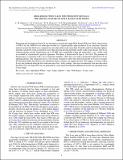HIGH-RESOLUTION X-RAY SPECTROSCOPY REVEALS THE SPECIAL NATURE OF WOLF-RAYET STAR WINDS
Author(s)
Oskinova, Lidia M.; Gayley, K. G.; Hamann, W.-R.; Ignace, R.; Pollock, A. M. T.; Huenemoerder, David P.; ... Show more Show less
DownloadOskinova-2012-HIGH-RESOLUTION X-RA.pdf (644.8Kb)
PUBLISHER_POLICY
Publisher Policy
Article is made available in accordance with the publisher's policy and may be subject to US copyright law. Please refer to the publisher's site for terms of use.
Terms of use
Metadata
Show full item recordAbstract
We present the first high-resolution X-ray spectrum of a putatively single Wolf-Rayet (WR) star. 400 ks observations of WR 6 by the XMM-Newton telescope resulted in a superb quality high-resolution X-ray spectrum. Spectral analysis reveals that the X-rays originate far out in the stellar wind, more than 30 stellar radii from the photosphere, and thus outside the wind acceleration zone where the line-driving instability (LDI) could create shocks. The X-ray emitting plasma reaches temperatures up to 50 MK and is embedded within the unshocked, "cool" stellar wind as revealed by characteristic spectral signatures. We detect a fluorescent Fe line at ≈6.4 keV. The presence of fluorescence is consistent with a two-component medium, where the cool wind is permeated with the hot X-ray emitting plasma. The wind must have a very porous structure to allow the observed amount of X-rays to escape. We find that neither the LDI nor any alternative binary scenario can explain the data. We suggest a scenario where X-rays are produced when the fast wind rams into slow "sticky clumps" that resist acceleration. Our new data show that the X-rays in single WR star are generated by some special mechanism different from the one operating in the O-star winds.
Date issued
2012-02Department
MIT Kavli Institute for Astrophysics and Space ResearchJournal
The Astrophysical Journal. Letters
Publisher
IOP Publishing
Citation
Oskinova, L. M., K. G. Gayley, W.-R. Hamann, D. P. Huenemoerder, R. Ignace, and A. M. T. Pollock. “HIGH-RESOLUTION X-RAY SPECTROSCOPY REVEALS THE SPECIAL NATURE OF WOLF-RAYET STAR WINDS.” The Astrophysical Journal 747, no. 2 (February 21, 2012): L25. © 2012 The American Astronomical Society
Version: Final published version
ISSN
2041-8205
2041-8213